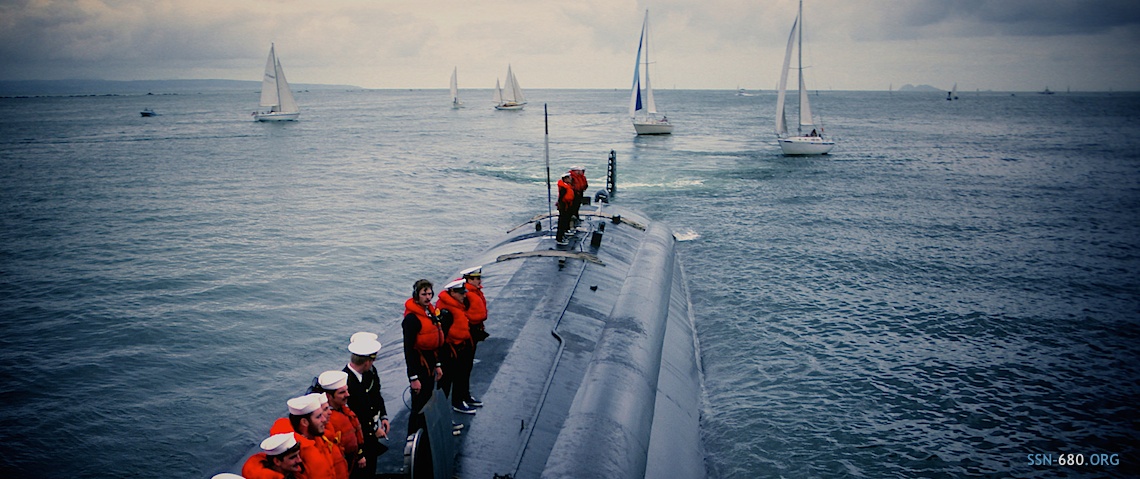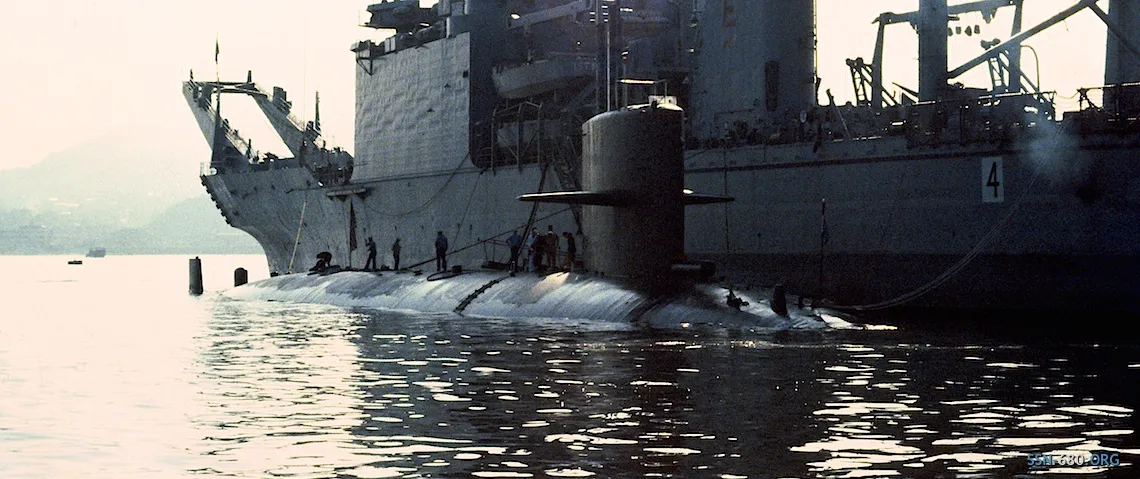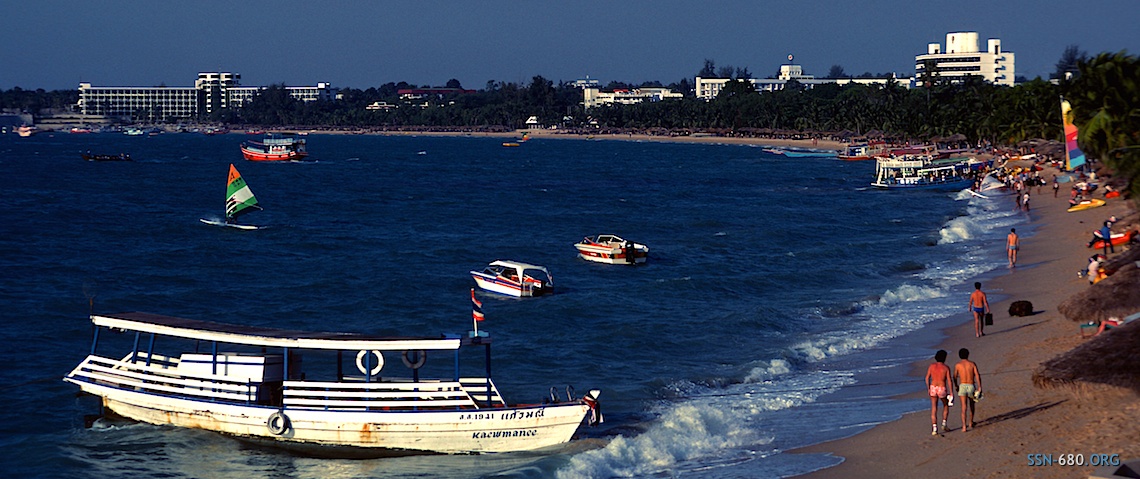Up Scope!
Photographs and Memories

It has been said that a picture is worth a thousand words. From this perspective, some thirty years or so after last setting foot on that 300 foot tube of black steel that had been my home for four years, they seem worth a lot more than that.
These images bring those antique memories to life, and in them, we hope you find pleasure as you explore the USS WILLIAM H. BATES (SSN 680), revisit those exotic ports, and find the faces of old friends.
 No comments
No commentsName-A-Sailor

Not to be confused with the ever-popular Dial-A-Sailor we remember from our days in Perth, W.A., the Name-A-Sailor feature lets you contribute and help identify shipmates from thirty year old photos before all our collective knowledge is lost to time. Working in conjunction with the Name-A-Sailor tab, you can easily identify people, times, and places in photographs featured on the site.
For those that visit routinely, we all know that many of the photographs on the site don’t identify the individuals, mostly because our memories are not as iron-clad as they used to be, but also because the site contains photos from thirty years of the U.S.S William H. Bates, and since each of us was only on-board for two to six of those, we can’t possibly know everyone by sight.
We’ve always encouraged viewers to let us know if they recognize shipmates and family that are not identified in photos, so their names can be added in the captions, but the help has been slow in coming, perhaps because it is just too hard to add a comment or email just to clear things up.
Regardless of the reason, here’s where Name-A-Sailor comes in. Now, when you are logged in, there will be a tab on the right side of your browser window right where the Registration tab is when you are not logged in. Clicking on Name-A-Sailor brings up a simple form that emails us directly and easily when you identify a shipmate or family member that is not identified, or identified incorrectly in the caption or text.
On the photographs in this section of Up Scope, we have conveniently numbered each person in the image so that you can easily tell us who is who. Simple click on the Name-A-Sailor tab, and let us know what you know.
The Name-A-Sailor tab can be used on any page of the website. Simply fill in the form with the requested information, click submit, and you’re done. We can then update the caption or text, and your knowledge has been captured, to the benefit of everyone who browses the ssn-680.org website.
Crew Gallery
 The USS WILLIAM H. BATES (SSN 680) is more than a 300 foot long nuclear powered machine. Thirty years of service meant that about 1500 men served at some time in some capacity bringing the machine to life. The Crew Gallery shows the boat through their eyes, through your eyes, with photos taken by the iron men who carried the flag across the seven seas, who made the boat who she was.
The USS WILLIAM H. BATES (SSN 680) is more than a 300 foot long nuclear powered machine. Thirty years of service meant that about 1500 men served at some time in some capacity bringing the machine to life. The Crew Gallery shows the boat through their eyes, through your eyes, with photos taken by the iron men who carried the flag across the seven seas, who made the boat who she was.
If you have photographs, you can upload your images to the various categories in the Crew Gallery. Share your history now!
The Seventies
 In 1970 the good ship USS WILLIAM H. BATES (SSN 680) was still just a collection of parts in a shipyard in Pascagoula, Mississippi. Prior to the death of her namesake in 1969, she was still called the Redfish, but by her launching in December of 1971, she carried the name of Congressman William H. Bates, a long-time staunch supporter of the nuclear navy.
In 1970 the good ship USS WILLIAM H. BATES (SSN 680) was still just a collection of parts in a shipyard in Pascagoula, Mississippi. Prior to the death of her namesake in 1969, she was still called the Redfish, but by her launching in December of 1971, she carried the name of Congressman William H. Bates, a long-time staunch supporter of the nuclear navy.
Sea trials started in February of 1973, and she was commissioned in May, and assigned the homeport of New London, Connecticut.
Deployment to the eastern Atlantic in 1974 for her first patrol mission took her to Holy Loch, Scotland and Halifax, Nova Scotia on the way home. Her next patrol took her back east and a stop in Holy Loch again, and Faslane, Scotland for a brief visit.
A refit in Norfolk Navy Shipyard, and local ops out of Ft. Lauderdale during 1975 were a brief respite before transiting back to the east Atlantic for NATO exercises 'Moby Dick' and 'Ocean Safari 75'. December brought her back to New London for the holidays.
 The following year saw her first Med run, leaving New London in May, and visiting exotic foriegn ports such as Bizerte, Tunisia, Augusta Bay, Sicily, and La Spezia and Naples, Italy. After departing the Mediterranean in September 1976, the submarine took part in Exercise "Ocean Safari 76" and returned to Groton in November.
The following year saw her first Med run, leaving New London in May, and visiting exotic foriegn ports such as Bizerte, Tunisia, Augusta Bay, Sicily, and La Spezia and Naples, Italy. After departing the Mediterranean in September 1976, the submarine took part in Exercise "Ocean Safari 76" and returned to Groton in November.
After another refit, she departed Groton during the summer of 1977 transiting the North Sea for a port visit to Bremerhaven, Germany, and taking part in Exercise "Ocean Safari 77" with NATO units while returning from European waters to Groton.
From there, USS WILLIAM H. BATES (SSN 680) operated in the Atlantic until moving to San Diego in May 1978 for service in the Pacific Fleet, calling San Diego homeport until the end of the decade.
The Eighties

The eighties were interesting years for USS WILLIAM H. BATES (SSN 680). By 1980 she was in refueling overhaul in Bremerton, Washington, where she gained the distinctive 'hood-scoop' that marked her as a special project boat and was her unique identifier during the first half of the decade.
Returning to her home port of San Diego by late 1981, after a brief stop in Nanaimo, British Columbia, she embarked on a year of weekly ops and special testing of her pronounced protuberance and associated 'special' features.
Her first WestPac of the 80's would start in September 1982, taking her to the western Pacific, and ports-of-call including Pearl Harbor, Hawaii, and Yokusuka, Japan. After a few months in the Sea of None of Your Business, she would anchor out in Sasebo, Japan, then on to Subic Bay, Phillipines, and Sattahip, Thailand. Back to Subic Bay, then onto Guam for a brief stay in a floating drydock, another trip to places unmentionable, and she stopped at Adak, Alaska before returning to San Diego in March. Only home for a few weeks, she moved to the drydock at Mare Island Naval Shipyard for some extensive rework by the local body and fender experts.
 Back to San Diego, we'd head back out in September for WestPac 83-84. Straight to Subic Bay and this time she was called to the Indian Ocean. A brief stop at Diego Garcia for some steam plant band-aids, and then she was off to patrol the western end of the Indian Ocean. Periscope liberty of Aden, Yemen, and Mombasa, Kenya, were the highlights of that tour, before she returned to Diego Garcia for a quick pit stop. Next port-of-call, Perth, Western Australia, then, despite promises of Hobart, Tasmania, and Sydney, Australia, she made her way back to Guam, then home in February, 1984.
Back to San Diego, we'd head back out in September for WestPac 83-84. Straight to Subic Bay and this time she was called to the Indian Ocean. A brief stop at Diego Garcia for some steam plant band-aids, and then she was off to patrol the western end of the Indian Ocean. Periscope liberty of Aden, Yemen, and Mombasa, Kenya, were the highlights of that tour, before she returned to Diego Garcia for a quick pit stop. Next port-of-call, Perth, Western Australia, then, despite promises of Hobart, Tasmania, and Sydney, Australia, she made her way back to Guam, then home in February, 1984.
The rest of the year was spent in weekly ops, winding up with preparations to sail early January for WestPac 85. For January it was Yokosuka, Japan, then off the Sea of None of Your Business, Chin Hae, Korea, back to Yokosuka, Japan, and then down to Subic Bay. Next stop, Sattahip, Thailand, then back to Guam then home for ORSE preps.
The next WestPac of the eighties would be WestPac 87-88. The decade would wind down with a trip back to Vallejo, California, and on to Bremerton, Washington for another refueling.
The Nineties
The Nineties -
Looking for galleries from the Nineties! If you have photos from this time period, contact the Site Administrator using the link at the bottom of the page, and let's get your history up here!
The 2Ks
The 2Ks - the last years of the USS William H. Bates.
Looking for galleries from the final years of the Bates - if you have photos, contact the Site Administrator using the link at the bottom of the page, and let's get your photos up here!
Related Photos
 Related Photos contains images that might be of interest to former Bates sailors but may not necessarily be related directly to the USS William H. Bates.
Related Photos contains images that might be of interest to former Bates sailors but may not necessarily be related directly to the USS William H. Bates.
Photographs in this section have been gathered from various sources and collected over the years from other websites. Regrettably, the source or copyright owner may not be known. Please contact the Site Administrator if you have information related to the legitimate owner or creator so that usage permission can be obtained and proper credit given.






